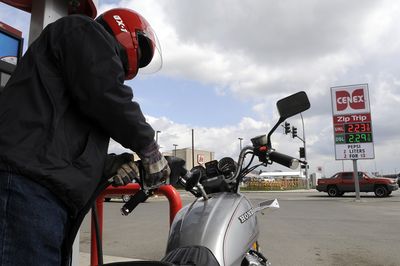Gas prices show an uptick, but aren’t likely to climb steeply

If you drive, you’ve surely noticed a touch of volatility in the price of gas during the past year.
Last April, prices in Spokane crested above $3.60 and were on their way to a record high of $4.19 a gallon for regular unleaded, according to the AAA Fuel Gauge report. Then they plunged in the fall – dropping below $1.50 around Christmas as the recession began showing its ugly face and worldwide demand tanked.
And now they’re climbing again, though experts aren’t predicting anything like record prices this year. “We saw prices hit a low at the end of last December, and they’ve been gradually rising since then,” said Cassie Devaney, AAA spokeswoman in Spokane.
Devaney said that it’s common for prices to rise in the spring and summer, then fall in the autumn and winter. The federal government, meanwhile, is predicting that through summer, prices will remain stable and well below last year’s levels, though they’re going up now due to rising crude oil prices and a recovery from record lows for refineries’ profit margins.
Here are some questions and answers about gas prices as we enter the peak driving season.
Q: Where are prices right now?
A: Spokane’s average price-per-gallon for regular unleaded was $2.30 at the end of last week, according to AAA. That’s an increase of 10 percent over a month ago. And it’s down 36 percent from a year ago.
In Coeur d’Alene, where prices tend to hover 10 to 20 cents below Spokane’s, the average is $2.09 – and the typical prices there have changed by roughly the same proportion in the last month and year.
Q: How do we compare with the rest of the country?
A: We’re on the high side lately. The national average is $2.06. Since February, Spokane prices have been running about 20 cents higher than the national average – a reversal of the situation during the previous several months.
Q: Has the rise and fall of gas prices affected driving overall?
A: Americans drove less last year as gas prices rose. Federal statistics show that the number of miles driven actually dropped in 2008 – the first decline in almost 30 years, according to the Department of Transportation. The biggest drop came in November, when Americans drove 5.3 percent less than the previous year, according to the DOT.
The idea of greater fuel efficiency has been popular for several years, in part due to reasons other than price – such as concerns over global warming. A February survey by the Consumer Federation of America showed that, when purchasing their next vehicle, those surveyed planned to buy a more efficient car – at an average of 29 mpg.
But the survey also showed that changes in behavior may lag behind intentions: 44 percent of those surveyed said they were driving about the same as last year, and 15 percent were driving more. In terms of sales, hybrid vehicles have been doing even worse this year than the rest of the auto industry.
Q: When prices dropped, did people start driving a lot again?
A: Not immediately. Devaney said the AAA is seeing evidence that people have maintained some of the conservative habits developed during peak prices. And the experts say that makes sense – projections call for a return to record high gas prices once the economy stabilizes. A report from the McKinsey Global Institute predicts a second “oil-price shock” sometime in the next few years if radical efficiency measures aren’t undertaken.
Still, people are a bit less daunted about driving. The recent short-term outlook prepared by the federal Energy Information Administration predicts a 1 percent increase in gas consumption this year.
Q: What’s with the price difference between Spokane and Coeur d’Alene?
A: The biggest single factor is taxes: A gallon of gas comes with 37.5 cents in taxes in Washington, and 25 cents in Idaho. The price gap between the cities has tended to range from 10 to 20 cents, so the tax difference accounts for a lot of it.
Devaney said another factor is the cost of doing business. Idaho’s minimum wage, for example, is $2 an hour lower than Washington’s. “That can have a big impact,” she said.
Q: What about the price differences among gas stations in the same town?
A: The vast majority of gas stations are independent operators, each of which has different contracts and costs with its wholesaler and different business expenses, Devaney said.
That means you get a great variety in prices. As of Friday, according to spokanegasprices.com, you could find gas priced at $2.22 to $2.39 at different stations around town – and everything in between.
Q: What does the future hold?
A: The EIA’s latest short-term energy outlooks calls for average gas prices nationwide of $2.23 per gallon during the summer. It’s impossible to say how that might play out specifically here – but it does suggest that huge price increases don’t seem likely.
Q: How certain is that prediction?
A: About this certain, according to a caveat from the EIA: “However, because short-term prices can be quite volatile, weekly prices will be higher (or lower) than the monthly average. In addition, if consumption turns out to be greater than projected in this Outlook, there could be increases in the monthly price averages.”